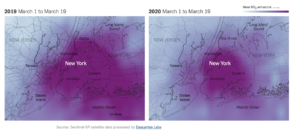Newsbrief: The effects of the Coronavirus on traffic and pollution
by Alyssa Lewis
As schools, businesses, office buildings, and restaurants close due to the coronavirus, traffic and pollution triggered by large cities in the US are declining, according to the New York Times.
Satellites have been used to detect emissions, specifically nitrogen dioxide, directly connected to cars and trucks, over Los Angeles, Seattle, New York, Chicago, and Atlanta.

(Photo: the New York Times)
As those around the country are encouraged to stay home, the traffic in Los Angeles 53% faster during the Wednesday morning commute, and 71% faster during the 5 pm commute than normally seen. In New York, the afternoon traffic rush on Wednesday moved 36% faster than normal.
The Bay Area saw a 40% decrease in the number of cars traveling eastbound between San Francisco and Oakland. There was a 40% decrease in traffic going into Seattle on March 8th after workers were encouraged to telecommute.
Seattle had one of the earliest recognized cases of coronavirus in the country. There has been less traffic on Saturdays demonstrating less social and recreational trips.

(Photo: the New York Times)
Less travel is expected to have contributed to a 50% decrease in carbon monoxide levels in New York.
Scientists do caution that the decrease in pollution due to the coronavirus is not the solution, as levels are expected to rise once again after the virus.

J1 student Alyssa Lewis volunteered to write this newsbrief out of a belief that FPU students deserve good journalism in this time of crisis.


